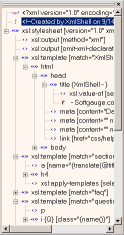| XmlTree View |

XmlTree view displays the tree structure of the XML document.
XmlShell provides several options for the visual representation of the XML nodes in the XmlTree view:
| Node Type | Displayed Text |
|---|---|
| XML Declaration | <?xml version='1.0' ...?> |
| CDATA | <![CDATA[...]]> |
| Comment | <!--comment text--> |
| Element | Tag name |
| Process Instruction | Target |
| Text | Text |
Multiple selection is a unique feature of XmlShell. It lets you to select more than one node in the XmlTree view. Simply use the standard methods to do multiple selection.
Use mouse to do multiple selection:
Use keyboard to do multiple selection:
XmlTree view supports drag & drop within its own tree and between trees in two documents. Drag & drop within the same document will move the selected nodes. You can press Ctrl while dragging and dropping to copy (instead of move) nodes. Drag & drop between two different documents will always copy nodes. To drag & drop multiple nodes, just first select the nodes, then start dragging by dragging from one of the selected nodes. Drag & drop between two different instances of running XmlShell is not supported, because the task can be done by opening two files in the same instance of XmlShell.
Auto expand/collapse is a feature to let a user expand/collapse a node while in middle of drag & drop. If you position the mouse cursor to the small expand/collapse (+ / -) buttons next to the node icons while you are in middle of drag & drop, the node will automatically expand/collapse.
In-place editing is a feature that users can edit the node right at the tree node label. While a node is selected, you can use one of the following methods to start in-place editing:
To end editing and accept changes, just click outside the edit box or press Enter.
To discard changes, just press Escape.
When the first time XmlTree view displays, if the XML document is not well-formed, the tree will be blank. User can edit the document through Editor View. Everytime when a user switch from Editor View to XmlTree View, XmlShell will check the document for well-formedness (if necessary). XmlTree View will repopulate its tree only when the document is well-formed. Once the tree is populated, a user can start working directly on the tree or any other grid-like views. In such a case, it's possible to generate non-well-formed tree. XmlShell doesn't enforce the well-formedness when the document is still under editing, but XmlShell always gives warning when you try to save a non-well-formed document.
Every single change to the tree or tree nodes can be undone before the tree gets repopulated from Editor View. This functionality is accessible through one of the following methods:
Navigation history functions like "Back" and "Forward" in Windows Explorer. It records the history of the tree navigation. This functionality is accessible through one of the following methods:
The following mouse operations are specific to XmlShell:
The tree control used in XmlTree View works the same way as the Windows system tree control. All standard keyboard operations should apply. The following is a simple summary:
XmlTree View can be docked on any edge of the main XmlShell window. Drag on the 'grip' bar of the view window to change docking position.
XmlTree view related configuration keys are listed below: